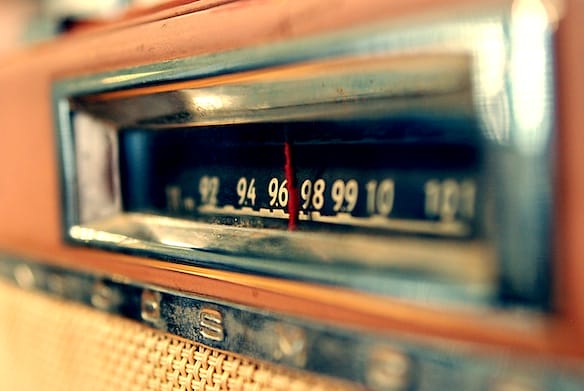
Image credit: Maryosee89.
Radio Tuners
Those seeking instrument tuners will have to wait for their article, as this segment of the Priceonomics Audiophile Guide will focus on tuners that receive radio bands, AM, FM, Satellite and internet radio. In the past it was a symbol of having excelled mid-level sound gear and entering the realm of audiophile quality components to have a stand-alone tuner and amplifier rather than a receiver that integrated the tuner with the amplifier function. Now the nature of radio has changed, though the wavelengths remain the same.
Forms
Currently, it is a measure of sophisticated equipment to encompass all forms of radio reception in a single unit that receives the traditional terrestrial forms of AM (amplitude modulation), and FM (frequency modulation), in addition to internet-originating streaming radio signals, satellite-conveyed radio signals, and high-definition radio. Unfortunately, gear that accesses these varying forms of source signals tends to be expensive, sometimes prohibitively, so we will look at a few available products which address this general need, if not those of the analog-only aficionados, for whom a line of high-end tuners has been designed.
Terrestrial Radio
AM and FM radio signals are electromagnetic waves that broadcast from a transmitter below the range of visible sight. The zone in which these energy forms occur in the electromagnetic spectrum is known as radio waves, which are in a constant state of flux. This movement is known as modulation, and the means of modulation specifies the type of radio wave being broadcast.
These waves follow the shape of a sine curve, with the difference in height of the repeating curves measured between the peaks and valleys, and defined as amplitude. The distance between adjacent peaks is the rate at which they modulate over time, or frequency.
It follows that the radio waves that modulate in length are known as Frequency Modulation, or FM; and those that modulate in height are known as Amplitude Modulation, or AM. Given the different nature of the radio waves, it follows that AM and FM waves have different features unique to their waveforms. AM, though susceptible to more atmospheric and physical (line of sight) interference, can travel far greater distances than FM, although FM waves can provide cleaner broadcast fidelity and reliability and is not interrupted by most physical forms of interference such as bridges, buildings and mountain ranges, to be received by a transmitter tuned to the specific frequency.
HD Radio
High-definition radio uses a digital signal rather than the traditional analog signal, which provides for some interesting differences and expansions on the analog model. In terms of listening experience it purportedly makes AM sound as good as FM, and takes the noise out of an FM signal, such as static, pops and non-signal based distortion.
HD radio should not be confused with internet or satellite radio as it is not either of these forms but rather an expansion of terrestrial radio.
In terms of flexibility, a digital signal can be split, so that multiple streams can be incorporated into one, giving a capacity for additional information that analog broadcast was unable to carry. Title, artist and track information can be received in the form of text, opening opportunities for archiving and documenting, tagging tracks for purchase, as well as indexing material for later replay. By being able to multicast, digital radio also opens opportunities for niche programming, creating greater diversity among the listener’s choices.
Internet Radio
Internet radio is a streaming format webcast that is transmitted on the world-wide web. It can take a couple of forms. With a station such as Pandora, the user specifies an artist, song, or release, (or several of these,) and the streaming engine prepares a playlist based on the information given. Another form, like radio paradise, might just play a preprogrammed playlist based on feedback from listeners. Most internet radio sources are available for free, and can be received via an online computer, or any other device with broadband connectivity.
Satellite Radio
Satellite radio is generally a paid subscription service that broadcasts a radio signal through a network of satellites. The technology required to receive the signal is handled proprietarily, and the equipment required to receive it is generally purchased in conjunction with the subscription. Many terrestrial radio tuners can be adapted to receive satellite signals with a plug and play tuner. It requires a clear line of sight between the antenna (a satellite dish) and the satellite to perform properly.
Products
NAD offers the c446 digital media tuner, which contains a digital music player in addition to FM, AM and internet radio. It also supports multiple networked sources using DLNA and universal plug-and-play technology. It has a USB interface that will dock iproducts and an integral 24-bit 192kHz audiophile-quality DAC. It supports most digital file formats as well as cloud-based music services for around $700.
The Cambridge Audio 650T is a high-fidelity AM and FM tuner which provides satellite radio with the installation of a plug-and-play Sirius antenna device and a subscription. It claims to provide superior FM broadcast quality due to a separate analog domain for the FM and AM tuners, a proprietary feature. It also features Natural Contour Technology to reshape the “flattened” contours of compressed files, for about $300.
The Cambridge Audio AR-30 provides for a Sirius radio plug-and-play tuner in addition to AM/FM and an iproduct dock, which will provide internet radio streaming. It includes a Radio Data System display, for printing the text from HD radio sources. It has bells and whistles like a front mini-jack input for music players, an output RCA jack for a subwoofer, 3 audio inputs, remote control and sleep and alarm timers. It is available for around $500.



